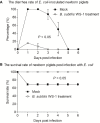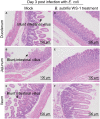A Newly Isolated Bacillus subtilis Strain Named WS-1 Inhibited Diarrhea and Death Caused by Pathogenic Escherichia coli in Newborn Piglets
- PMID: 31249559
- PMCID: PMC6582243
- DOI: 10.3389/fmicb.2019.01248
A Newly Isolated Bacillus subtilis Strain Named WS-1 Inhibited Diarrhea and Death Caused by Pathogenic Escherichia coli in Newborn Piglets
Abstract
Bacillus subtilis is recognized as a safe and reliable human and animal probiotic and is associated with bioactivities such as production of vitamin and immune stimulation. Additionally, it has great potential to be used as an alternative to antimicrobial drugs, which is significant in the context of antibiotic abuse in food animal production. In this study, we isolated one strain of B. subtilis, named WS-1, from apparently healthy pigs growing with sick cohorts on one Escherichia coli endemic commercial pig farm in Guangdong, China. WS-1 can strongly inhibit the growth of pathogenic E. coli in vitro. The B. subtilis strain WS-1 showed typical Bacillus characteristics by endospore staining, biochemical test, enzyme activity analysis, and 16S rRNA sequence analysis. Genomic analysis showed that the B. subtilis strain WS-1 shares 100% genomic synteny with B. subtilis with a size of 4,088,167 bp. Importantly, inoculation of newborn piglets with 1.5 × 1010 CFU of B. subtilis strain WS-1 by oral feeding was able to clearly inhibit diarrhea (p < 0.05) and death (p < 0.05) caused by pathogenic E. coli in piglets. Furthermore, histopathological results showed that the WS-1 strain could protect small intestine from lesions caused by E. coli infection. Collectively, these findings suggest that the probiotic B. subtilis strain WS-1 acts as a potential biocontrol agent protecting pigs from pathogenic E. coli infection. Importance: In this work, one B. subtilis strain (WS-1) was successfully isolated from apparently healthy pigs growing with sick cohorts on one E. coli endemic commercial pig farm in Guangdong, China. The B. subtilis strain WS-1 was identified to inhibit the growth of pathogenic E. coli both in vitro and in vivo, indicating its potential application in protecting newborn piglets from diarrhea caused by E. coli infections. The isolation and characterization will help better understand this bacterium, and the strain WS-1 can be further explored as an alternative to antimicrobial drugs to protect human and animal health.
Keywords: Bacillus subtilis; Escherichia coli; biocontrol agent; genomic analysis; newborn piglets.
Figures







Similar articles
-
Screening of Bacillus strains as potential probiotics and subsequent confirmation of the in vivo effectiveness of Bacillus subtilis MA139 in pigs.Antonie Van Leeuwenhoek. 2006 Aug;90(2):139-46. doi: 10.1007/s10482-006-9067-9. Epub 2006 Jul 4. Antonie Van Leeuwenhoek. 2006. PMID: 16820971 Clinical Trial.
-
A Highly Pathogenic Strain of Porcine Deltacoronavirus Caused Watery Diarrhea in Newborn Piglets.Virol Sin. 2018 Apr;33(2):131-141. doi: 10.1007/s12250-018-0003-8. Epub 2018 Mar 22. Virol Sin. 2018. PMID: 29569144 Free PMC article.
-
Construction of Bacillus subtilis strain engineered for expression of porcine β-defensin-2/cecropin P1 fusion antimicrobial peptides and its growth-promoting effect and antimicrobial activity.Asian-Australas J Anim Sci. 2017 Apr;30(4):576-584. doi: 10.5713/ajas.16.0207. Epub 2016 Jun 30. Asian-Australas J Anim Sci. 2017. PMID: 27383796 Free PMC article.
-
Oral Administration of a Select Mixture of Bacillus Probiotics Affects the Gut Microbiota and Goblet Cell Function following Escherichia coli Challenge in Newly Weaned Pigs of Genotype MUC4 That Are Supposed To Be Enterotoxigenic E. coli F4ab/ac Receptor Negative.Appl Environ Microbiol. 2017 Jan 17;83(3):e02747-16. doi: 10.1128/AEM.02747-16. Print 2017 Feb 1. Appl Environ Microbiol. 2017. PMID: 27881419 Free PMC article.
-
Biocontrol of the internalization of Salmonella enterica and Enterohaemorrhagic Escherichia coli in mung bean sprouts with an endophytic Bacillus subtilis.Int J Food Microbiol. 2017 Jun 5;250:37-44. doi: 10.1016/j.ijfoodmicro.2017.03.016. Epub 2017 Mar 24. Int J Food Microbiol. 2017. PMID: 28364624
Cited by
-
Isolation of a novel Bacillus subtilis HF1 strain that is rich in lipopeptide homologs and has strong effects on the resistance of plant fungi and growth improvement of broilers.Front Microbiol. 2024 Oct 1;15:1433598. doi: 10.3389/fmicb.2024.1433598. eCollection 2024. Front Microbiol. 2024. PMID: 39411434 Free PMC article.
-
Genomic insights into antimicrobial potential and optimization of fermentation conditions of pig-derived Bacillus subtilis BS21.Front Microbiol. 2023 Sep 29;14:1239837. doi: 10.3389/fmicb.2023.1239837. eCollection 2023. Front Microbiol. 2023. PMID: 37840708 Free PMC article.
-
Evaluation on the Growth Performance, Nutrient Digestibility, Faecal Microbiota, Noxious Gas Emission, and Faecal Score on Weaning Pigs Supplement with and without Probiotics Complex Supplementation in Different Level of Zinc Oxide.Animals (Basel). 2023 Jan 22;13(3):381. doi: 10.3390/ani13030381. Animals (Basel). 2023. PMID: 36766270 Free PMC article.
-
Probiotic Bacillus subtilis LF11 Protects Intestinal Epithelium Against Salmonella Infection.Front Cell Infect Microbiol. 2022 Feb 16;12:837886. doi: 10.3389/fcimb.2022.837886. eCollection 2022. Front Cell Infect Microbiol. 2022. PMID: 35252040 Free PMC article.
-
Important role of Bacillus subtilis as a probiotic and vaccine carrier in animal health maintenance.World J Microbiol Biotechnol. 2024 Jul 15;40(9):268. doi: 10.1007/s11274-024-04065-0. World J Microbiol Biotechnol. 2024. PMID: 39007987 Review.
References
-
- Bian X., Evivie S. E., Muhammad Z., Luo G. W., Liang H. Z., Wang N. N., et al. . (2016). In vitro assessment of the antimicrobial potentials of Lactobacillus helveticus strains isolated from traditional cheese in Sinkiang China against food-borne pathogens. Food Funct. 7, 789–797. 10.1039/C5FO01041A, PMID: - DOI - PubMed
-
- Borsodi A. K., Pollak B., Keki Z., Rusznyak A., Kovacs A. L., Sproer C., et al. . (2011). Bacillus alkalisediminis sp. nov., an alkaliphilic and moderately halophilic bacterium isolated from sediment of extremely shallow soda ponds. Int. J. Syst. Evol. Microbiol. 61, 1880–1886. 10.1099/ijs.0.019489-0, PMID: - DOI - PubMed
LinkOut - more resources
Full Text Sources

